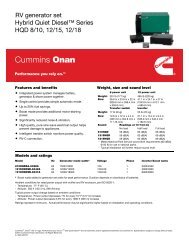Air Brake Manual
Air Brake Manual
Air Brake Manual
Create successful ePaper yourself
Turn your PDF publications into a flip-book with our unique Google optimized e-Paper software.
<strong>Brake</strong> Adjustment<br />
On vehicles equipped with hydraulic brakes it is<br />
possible to pump the brake pedal to compensate for<br />
brakes that are out of adjustment. This is not<br />
possible with a vehicle equipped with an air brake<br />
system with manual slack adjusters. When the<br />
brakes are adjusted by slack adjusters, the shoes<br />
are moved outwards. This brings them as close to<br />
the drums as possible minimizing the amount of free<br />
travel when the brakes are applied. It also reduces<br />
the volume of air used to apply the brakes.<br />
<strong>Brake</strong> adjustment (push rod travel) must be checked<br />
as part of the pre-trip air brake inspection (Section<br />
9).<br />
S-cam <strong>Brake</strong><br />
The following are recommended steps to determine<br />
if an S-cam brake with manual or automatic slack<br />
adjusters requires adjustment.<br />
· Ensure vehicle is secure and wheels are blocked.<br />
· Shut off the engine, leaving the transmission in a<br />
low gear or park then release the spring parking<br />
brakes.<br />
· Make a chalk mark where each push rod enters<br />
the brake chamber.<br />
· Reapply the spring parking brakes and measure<br />
the distance from the brake chamber to the<br />
chalk mark. Ensure the slack (push rod travel) is<br />
within 3/4 and 1 1/2 inches or within<br />
manufacturer’s specifications and the angle<br />
between the slack adjuster and push rod is 90°<br />
or as close as practical. If not, then a brake<br />
adjustment is required.<br />
<strong>Brake</strong> off<br />
<strong>Brake</strong> on<br />
Chalk mark<br />
Chalk mark<br />
Ruler<br />
When the brakes are out of adjustment, braking<br />
efficiency is reduced by three factors:<br />
1. <strong>Brake</strong> lag increases because additional air is<br />
required to fill and pressurize the increased<br />
chamber volume caused by the increased stroke<br />
of the push rod.<br />
2. The angle between the slack adjuster arm and the<br />
push rod becomes more than 90°, which results in<br />
a loss of force between the linings and<br />
the drum. (see diagram on page 18)<br />
3. The effectiveness of diaphragm brake chambers<br />
drops off significantly if the stroke exceeds 75% of<br />
its designed travel. For a type 30 chamber (30<br />
square inches of effective diaphragm area) that<br />
has a design stroke of 2 1/2 inches, the brakes<br />
should be adjusted at or before 1 1/2 inches of<br />
travel. With a working pressure of 100 psi this<br />
chamber will produce a force of 3,000 lb at 1 1/2<br />
inches of travel, but only 2,500 lb of force at a<br />
travel of 2 1/4 inches. Remember, when a chamber<br />
bottoms out, the force reduces to zero.<br />
66




